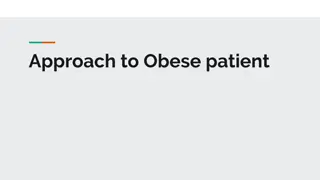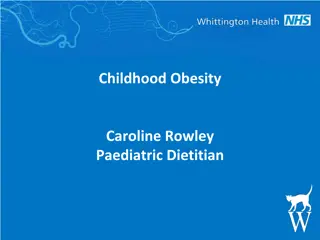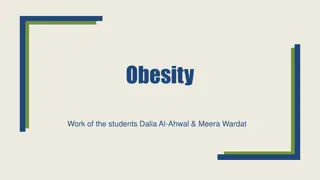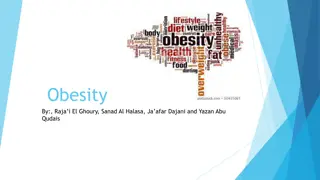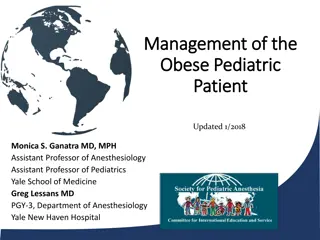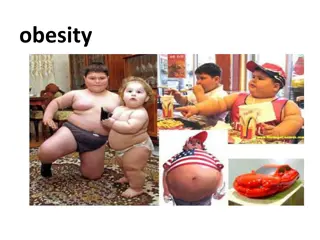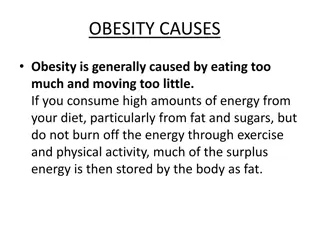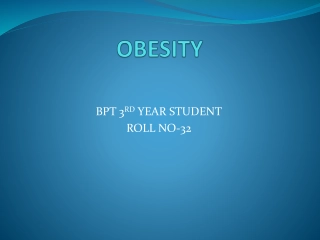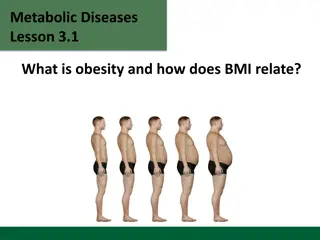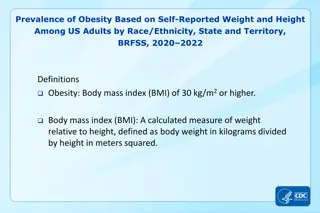Understanding Obesity: Definition, Causes, and Prevention
Obesity is characterized by abnormal or excessive fat accumulation, posing health risks. It is measured using Body Mass Index (BMI) and is classified based on BMI ranges. The prevalence, causes, prevention strategies, and classification criteria for obesity are essential in addressing this global health issue. Various methods, including BMI in children, skin fold thickness, waist circumference, and bioelectrical impedance analysis, can estimate obesity. Understanding the types of obesity, such as android (apple-shaped) and gynoid (pear-shaped), aids in recognizing associated health risks.
Download Presentation

Please find below an Image/Link to download the presentation.
The content on the website is provided AS IS for your information and personal use only. It may not be sold, licensed, or shared on other websites without obtaining consent from the author. Download presentation by click this link. If you encounter any issues during the download, it is possible that the publisher has removed the file from their server.
E N D
Presentation Transcript
Obesity DR. AFNAN YOUNIS & DR. HANI ALGHAMDI
Objectives 1- Definition and classification of obesity 2- Magnitude of the problem of obesity 3- Causes of obesity 4- Obesity prevention
Obesity definition: Overweight and obesity are defined as abnormal or excessive fat accumulation that presents a risk to health . Obesity is Body Mass Index (BMI) of 30 or higher. WHO: http://www.who.int/topics/obesity/en/
Body Mass Index (BMI): A measure of an adult s weight in relation to his or her height, specifically the adult s weight in kilograms divided by the square of his or her height in meters. Provides the most useful population-level measure of overweight and obesity Inexpensive & easy-to-perform screening for weight categories that may lead to health problems. Does not measure body fat directly, but correlates to direct measures of body fat.
Obesity classification With a BMI of: Below 18.5 18.5 - 24.9 25.0 - 29.9 30 or higher You are considered: Obesity class BMI (kg/m2) Underweight Healthy Weight Overweight Obese Class I 30.0- 34.9 Class II 35.0-39.9 Class III (Extreme Obesity) 40.0 CDC, NHLBI
BMI in children For children, age needs to be considered when defining overweight and obesity. Percentile Range Weight Status Category Less than the 5th percentile Underweight 5th percentile to less than the 85th percentile Normal or Healthy Weight 85th to less than the 95th percentile Overweight 95th percentile or greater Obese
Other methods to estimate obesity Skin fold thickness Waist circumference and waist to hip ratio Bio-impedance ( Bioelectrical impedance analysis (BIA) )
Types of obesity The fat distribution in the body is identified among the two types of obesity Android(apple obese) in which person stores fat around his or her abdominal region Gynoid (pear obese), in which excess fat are being deposited somewhere at the hip and thigh areas. Android obese individuals are more prone to obesity-related diseases compared to the gynoid obese.
Magnitude of problem Obesity prevalence The worldwide prevalence of obesity more than doubled between 1980 and 2014. in 2014, about 13% of the world s adult population (11% of men and 15% of women) were obese. And 39% of adults aged 18 years and over (38% of men and 40% of women) were overweight. In 2014, an estimated 41 million children under the age of 5 years were overweight or obese. overweight and obesity are now on the rise in low- and middle- income countries, particularly in urban settings. WHO: http://www.who.int/mediacentre/factsheets/fs311/en/
Prevalence of obesity in Gulf Countries (WHO estimates 2014) Country Qatar Kuwait United Arab Emirates Bahrain Saudi Arabia Oman Male 40% 35.5% 33.8% Female 49.7% 45.9% 45.1% Both 42.3% 39.7% 37.2% 30.5% 29.9% 27.2% 42.8% 41.4% 37.7% 35% 34.7% 30.9%
Data from KSA National Surveys Alquaiz J et al. Women Health in Saudi Arabia. PJMS 2014
Magnitude of problem cont. Obesity complications Overweight and obesity are linked to more deaths worldwide than underweight. Cardiovascular diseases (mainly heart disease and stroke), which were the leading cause of death in 2012 Diabetes Musculoskeletal disorders (especially osteoarthritis) Some cancers (including endometrial, breast, ovarian, prostate, liver, gallbladder, kidney, and colon). The risk for these noncommunicable diseases increases, with increases in BMI. Childhood obesity is associated with a higher chance of obesity, premature death and disability in adulthood. In addition to breathing difficulties, increased risk of fractures, hypertension, early markers of cardiovascular disease, insulin resistance and psychological effects.
Magnitude of problem cont. Double burden of disease In low- and middle-income countries While continue to deal with infectious diseases and undernutrition, there is an increase in noncommunicable disease risk factors such as obesity and overweight, particularly in urban settings.
Causes of obesity Multifactorial Increased intake of energy-dense foods that are high in fat. Increase in physical inactivity due to the increasingly sedentary nature of many forms of work, changing modes of transportation, and increasing urbanization. Genetic factors Hormonal factors
Prevention Goals of obesity control: Reduction in theincidenceof childhood, adolescent and adults obesity Reduction in the prevalence of childhood, adolescent and adults obesity. Reduction of mean population BMI levels Improvement in the proportion of childhood, adolescent and adults with dietary quality meeting the Dietary and physical activity Guidelines . Achievement of physical, psychological, and cognitive growth and developmental goals. A population with weight and fitness levels conducive to a productive society
Obesity prevention Primary prevention: Breastfeeding: the likelihood to become overweight is 20 to 40 percent less in babies breastfed for six months or longer Be a role model. Parents who eat healthy foods and are physically active set an example that increases the likelihood their children will do the same. Encourage physical activity. Children should have an hour of moderate physical activity most days of the week. Reduce time in front of the TV and computer to less than two hours a day. Encourage children to eat only when hungry, and to eat slowly. Avoid using food as a reward or withholding food as a punishment
Primary prevention cont. Avoid foods that are high in "energy density" or that have a lot of calories in a small amount of food. Create community environments that promote and support healthy food and beverage choices and physical activity. Prevent childhood obesity through early child-care and schools. Expand the role of health care and health service providers and insurers in obesity prevention. Expand the role of public and private employers in obesity prevention.
Secondary prevention: 1-Dietary Approaches to the Treatment of Obesity: Low-fat diets. Very-low-fat diets. Moderate-fat diets. The high -protein diet. Low-carbohydrate diets. Low-glycemic index (GI) diet 2-Increase physical activity Effective weight loss requires >150 min/week of exercise with an energy consumption rate of 1200 to 1800 kcal/week. Strength training alone is not very effective for weight reduction.
Secondary prevention cont. 3- behavioral modification 1- Self-monitoring: such as maintaining food diaries. 2- Stimulus control: the focus is on altering the environment that activates eating and modifying it to help in avoiding overeating. It includes proper purchase of food items, excluding energy-dense processed food from the shopping basket and introduction of more fruits and vegetables. Or altering the amount of food served on the table or reducing the size of plates and containers 3- Reinforcement of successful outcomes or rewarding good behaviors is important. 4- Goal setting: Setting realistic goals. 5- Slower eating 6- Nutritional education 7- Increasing physical activity 8- Social support: by including spouses and family members
Secondary prevention cont. 4-Weight-reducing drugs Drug therapy should only be carried out in combination with a basic program (diet, exercise, behavioral therapy). 5-Surgical intervention For extremely obese patients. 6- Mocrobiome and Microbiota as a new method of intervention!!
Tertiary prevention: For those who are already obese and showing signs or symptoms of end-organ disease, there are clinical preventive maintenance medicine strategies and treatment.
National programs Obesity Control Program <http://www.moh.gov.sa/en/OCP/Pages/default.aspx> Promote health of all age groups in Saudi Arabia through putting an end to obesity, as well as providing the highest means of protection, and offering integrated healthcare services to people suffering from any of the three levels of obesity. Objectives: The main long-term objective is to keep the incidence rate of obesity unchanged in the coming 10 years. This goal is adopted by the World Health Organization. Objective 1: Primary protection against obesity - reduction of the incidence rate of obesity through controlling its risk factors. Objective 2: Secondary protection against obesity early detection of cases. Objective 3: Improving the quality of the three-level health services provided for the obese people. Objective 4: Supporting the means of evaluation, follow-up, surveys, and studies on obesity Objective 5: Enabling the obese people and their families to contribute to controlling obesity and its complications, in addition to playing a role in providing health services and ensuring their quality. Objective 6: Promoting the community partnership to combat obesity.


